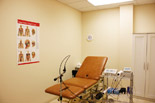Diabetic Foot Care
Just like anyone else, people with diabetes can develop the following types of foot conditions:
 Corn and callus | Corns and calluses are thick layers of skin caused by too much rubbing or pressure on the same spot. |
 Blister | Blisters can form if shoes always rub the same spot, or from wearing shoes that do not fit or wearing shoes without socks. |
 Ingrown toenail | Ingrown toenails occur when an edge of the nail grows into the skin, which can then get red and infected. Ingrown nails can be caused when someone cuts into the corners of toenails during nail trimming. Wearing shoes which are too tight can also cause ingrown nails. |
 Bunion | A bunion forms when the big finger slants towards the small toes, and a bump forms at the base of the big toe. This spot can get red, sore, and infected. Bunions may run in the family, but most often they are caused by wearing high-heeled shoes with narrow toes. These shoes put pressure on the big toe, pushing it toward the second toe. |
 Plantar warts | Plantar warts, which form on the bottom of the feet, are caused human papilloma virus (HPV). They tend to disappear without treatment. |
 Hammertoe | Hammertoes form when a foot muscle gets weak, shortening the tendons, which then retract the toe, causing it to curl under the foot and creating a bump at the joint on the top of the toe. They also may be caused by wearing shoes that do not fit properly (are too short). Hammertoes can cause problems with walking and can lead to other foot problems, such as blisters, calluses, and sores. |
 Dry and cracked skin | Dry skin can become cracked, allowing germs to enter. |
 Athlete's foot | Athlete's foot is caused by a fungus that causes redness and cracking of the skin. |





